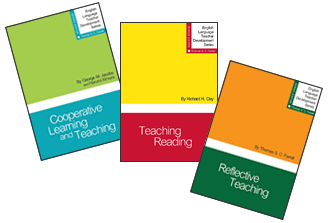Free Activities From New Ways in Teaching Vocabulary
The New Ways Series is a collection of activities and exercises for classroom practice. Here are three great activities for teaching reading from New Ways in Teaching Vocabulary.
What Is It?
|
Levels
Intermediate+ |
Aims
Individualize the revision of vocabulary |
|
Class Time
10 minutes |
Resources
Activity sheet |
Procedure
-
Prepare a sheet containing several sets of sentences such as:
It is like water.
Everybody has it.
It is warm when it belongs to people.
It is cold when it belongs to a fish.
It is usually red.
It is in your body.
What is it?
-
The learners work on the sheets in their own time and at their own speed. They mark their work from an answer key.
Caveats and Options
-
Arrange the sentences in a set so that the first sentences do not give a lot of information.
-
This activity can be used to teach vocabulary if the actual word is used instead of it. The learners respond by writing the L1 translation of the word.
Contributor
Paul Nation is Reader in Applied Linguistics at Victoria University of Wellington, New Zealand.
Follow Your Character
|
Levels
Intermediate+ |
Aims
Focus on a particular type of vocabulary |
|
Class Time
30 minutes |
Resources
Video segment |
Students pool their knowledge of vocabulary and create a coherent passage describing one character’s activities in a video passage. When video is used for language learning purposes, students often focus on just the dialogue. This activity is a way of focusing students’ attention on a different set of vocabulary items. By reducing the volume and giving each group a specific character and giving each group member a specific part of speech, the cognitive load is significantly reduced. This enables students to focus on aspects of the video passage and hence vocabulary that they would not focus on with more listening-based approaches.
This type of cooperative group work encourages students to pool their knowledge of vocabulary and teach each other. There is a considerable amount of interaction and negotiation of meaning that takes place as students work to create a paragraph to present to the class.
Procedure
- Choose a section of video from 20 seconds to 1 minute in length that has a lot of action and several characters.
- Split the class into enough groups so that each group has one character to watch.
- Each person in the group should watch the character and be in charge of taking note of the vocabulary related to one of the following categories: (a) actions, (b) objects, (c) descriptions of objects or people, and (d) descriptions of actions.
Play the video two or three times. Turning the volume off might help the students focus on the task.
- The students’ task will be to pool their vocabulary and from this group of words create a complete description of their character’s role in the scene.
- Have them write a paragraph for one of the group members to then read to the class.
The following is an example from the introduction to “The Simpsons,” a popular U.S. TV show, which I have used in my class.
First Bart leaves school on his skateboard. He is wearing a yellow striped shirt and short pants. He drives dangerously past three people on the sidewalk. Homer throws away a green radioactive rod that almost hits him. Finally, Bart jumps over the car and goes into the house and sits on the old couch with the family.
Contributor
Eric Bray is Academic Director at the Kyoto YMCA English School, in Japan.
Word Building
|
Levels
Intermediate+ |
Aims
Develop knowledge of word forms
Extend the range of meanings for known words |
|
Class Time
20 minutes
Prep Time
5 minutes |
Resources
None |
Procedure
- Choose a set of words or forms to work with. These could be prepositions, prefixes or suffixes, phrasal verbs (e.g., the preposition against; or the suffix –ful).
- Ask students to form groups and to think of many ways in which the word can be used. In the case of against, for example, students might produce:
Lean against the wall.
I’m against your suggestion.
For and against.
It’s against my expectation.
I’m not against what you say.
It’s against the law.
- Set a time limit and let students use their imaginations. By pooling their resources, they should be able to generate at least six or more examples.
- Ask groups to read out their examples. Give further explanations concerning usage. Correct any unacceptable explanations and give reasons.
After all the examples have been gathered, get the class to classify them into meaning groups or to find the underlying meaning of the item.
Contributor
Ronald Jackup is a freelance ESL teacher and writer.
________________________
These activities were originally published in New Ways in Teaching Vocabulary, published by TESOL. TESOL retains all copyright.
Nation, P. (Ed.). (1994). New ways in teaching vocabulary. Alexandria, VA: Teachers of English to Speakers of Other Languages, Inc. (TESOL).
TESOL Blogs
Interested in writing a blog for TESOL?
Contact
Tomiko Breland with your idea or for submission details.
Check out the latest TESOL Blogs:
|
Guest Writer: Tech Training & Tutorials via EdTech.tv, by Tara Arntsen
 Today I have a really special post for you about EdTech.tv, a great website for teachers to learn about using technology. EdTech.tv was started this year by Brent Warner, an ESOL educator and tech enthusiast based in California. Brent was a classmate of mine at USC, so he even agreed to tell you about the site himself. I am thrilled to be able to introduce you to EdTech.tv and hope you check it out today. Take it away, Brent! Today I have a really special post for you about EdTech.tv, a great website for teachers to learn about using technology. EdTech.tv was started this year by Brent Warner, an ESOL educator and tech enthusiast based in California. Brent was a classmate of mine at USC, so he even agreed to tell you about the site himself. I am thrilled to be able to introduce you to EdTech.tv and hope you check it out today. Take it away, Brent!
“If you can’t meet your students where they are, they’ll never follow you where you want to take them.”
Being a teacher in today’s environment is far different than at any other time in the history of education. In the past, inventions such as chalk boards, film projectors, OHPs, and the like helped us find different ways to connect with our students. We had years to work with them and master them, and, frankly, not a lot of thought went into stretching their true potential. Read More. |
|
Look Into My Eyes…and Learn Unforgettable Vocabulary!, by Alexandra Lowe
 Sometimes, you get lucky. A planned activity that you hope will be moderately interesting and instructive turns into a runaway success. Here’s one: Sometimes, you get lucky. A planned activity that you hope will be moderately interesting and instructive turns into a runaway success. Here’s one:
Inspired by a recent article in the New York Times that reported that reading Chekhov was the best way to learn to interpret other people’s body language, I was lured into taking the Times’ online quiz to see how good I was at reading visual cues. As it turned out, I had inadvertently latched onto what became a wildly popular vocabulary and speaking activity. Read More. |
|
Best Language Learning Games: Part 2 of 5, by Marc Anderson
 Last week, the language game Scrambleword was featured as one of my top learning games for ELL students. This week I thought I would share a version of the game Smart Mouth. It’s a quick-thinking word game that can be played individually or in teams, and it is designed to promote quick thinking, increase vocabulary, and build spelling skills. Read More. Last week, the language game Scrambleword was featured as one of my top learning games for ELL students. This week I thought I would share a version of the game Smart Mouth. It’s a quick-thinking word game that can be played individually or in teams, and it is designed to promote quick thinking, increase vocabulary, and build spelling skills. Read More.
|
TESOL Bookstore

LOOKING FOR HOLIDAY GIFTS FOR COLLEAGUES?
GIVE A BOOK FROM TESOL PRESS
AND TAKE ADVANTAGE OF FREE SHIPPING*
 ESL and Digital Video Integration: Case Studies
ESL and Digital Video Integration: Case Studies
Edited by Jia Li, Nicolas Gromik, and Nicholas Edwards
Seven original case studies demonstrate how video can be an effective and powerful tool to create fluid, fun, interactive, and collaborative learning environments.
 Language Teaching Insights From Other Fields: Sports, Arts, Design, and More
Language Teaching Insights From Other Fields: Sports, Arts, Design, and More
Edited by Christopher Stillwell
A fun read full of practical tips from language teachers who bring their insights to the classroom from extensive experience in other fields.
English Language Teacher Development Series
Thomas S. C. Farrell, series editor

Short ● Practical ● Interactive ● 15 Individual Topics
Buy Them All—20% OFF purchase of 3 or more
Each affordable book offers a variety of practical methods and time for reflections that allow teachers to interact with the materials presented.
*For up to 5 books to USA and Canada!
To Order:
Online: www.tesol.org/bookstore